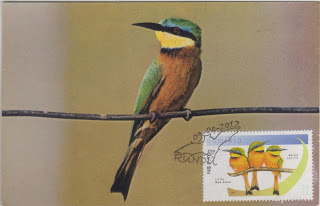From top to bottom :
Inland registered mail : European Bee-eater (黃喉蜂虎)
Standard mail : White-fronted Bee-eater (白額蜂虎)
N$5,70 : Southern Carmine Bee-eater (南紅蜂虎)
N$6,80 : Swallow-tailed Bee-eater (燕尾蜂虎) ; N$7,70 : Little Bee-eater (小蜂虎)
Namibia (2015)
5th February, 2016. Windhoek
26th February, 2016. Hong Kong
Inland registered mail : European Bee-eater (黃喉蜂虎)
Standard mail : White-fronted Bee-eater (白額蜂虎)
N$5,70 : Southern Carmine Bee-eater (南紅蜂虎)
N$6,80 : Swallow-tailed Bee-eater (燕尾蜂虎) ; N$7,70 : Little Bee-eater (小蜂虎)
Namibia (2015)
5th February, 2016. Windhoek
26th February, 2016. Hong Kong
With their colourful aerobatics, bee-eaters are amongst the most striking of all small birds. As their name implies, bee-eaters live on bees and other flying insects, which they hawk in flight during spectacular aerial pursuits, or snatch from vegetation or the ground. Using their long, sharp, curved bills, the birds will pound stinging insects against a perch to discharge their sting before eating them. Bee-eater species vary significantly in size, yet all are relatively small birds with intricately-coloured plumage. Most bee-eaters are gregarious and roost together, as well as congregating on favourite perches that overlook ideal hunting grounds. Some species nest in large colonies, gathering in spectacular flocks during the breeding season. Some migrate to Namibia from other parts of Africa or Europe and are seen in our country only during the summer months.
European Bee-eater (黃喉蜂虎)
Namibia (2015)
9th April, 2012. Rundi
Namibia (2015)
9th April, 2012. Rundi
Southern Carmine Bee-eater (南紅蜂虎)Namibia (2015)
9th April, 2012. Rundi/span>
9th April, 2012. Rundi/span>
Little Bee-eater (小蜂虎)Namibia (2015)
9th April, 2012. Rundi
9th April, 2012. Rundi









No comments:
Post a Comment